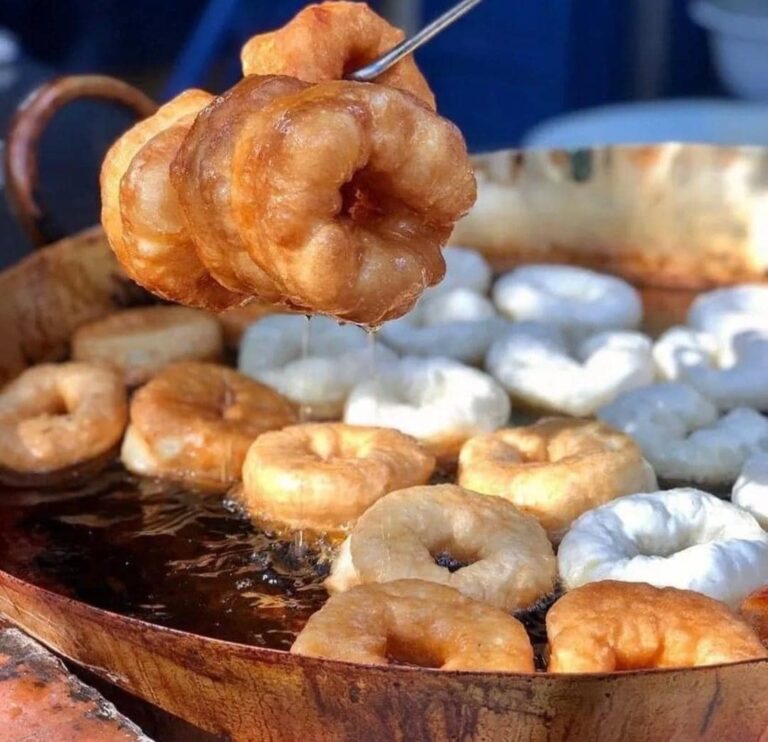
Sfenj

Moroccan street food is rich with flavours and textures, but few treats are as beloved as Sfenj, the Moroccan doughnut. Crispy on the outside, soft and airy on the inside, this doughnut is a simple yet irresistible snack that locals enjoy with a hot cup of mint tea. Sfenj is made from a basic yeast dough that’s fried to golden perfection and often enjoyed plain or dusted with sugar. Whether you’re walking through the bustling medinas of Marrakech or Fez or stopping at a small street vendor in a rural town, Sfenj is a must-try street food in Morocco.

The History of Sfenj
The word “Sfenj” comes from the Arabic word for “sponge,” referring to the doughnut’s light and airy texture. Sfenj has been a staple in Moroccan cuisine for generations and is often associated with breakfast or mid-morning snacks. Though its origins are difficult to pinpoint, Sfenj likely evolved from early North African bread-making traditions, with cooks using simple dough to create a quick, fried pastry.
Sfenj is enjoyed throughout Morocco and in many other parts of North Africa and the Middle East, where variations of the doughnut can be found. In Morocco, it has become a symbol of street food culture, bringing people together over shared plates of freshly fried doughnuts, whether in the morning or late afternoon.
What Makes Sfenj So Special?
What sets Sfenj apart from other types of doughnuts is its simplicity and unique texture. Made from only a handful of ingredients—flour, water, yeast, and salt—the dough is left to rise until it becomes light and fluffy. The dough is then shaped into rings by hand, which gives Sfenj its distinctive uneven, rustic look. After being fried in hot oil, the doughnuts puff up and develop a crispy, golden-brown exterior while remaining soft and chewy on the inside.
Unlike many Western doughnuts, Sfenj is not overly sweet. It’s often eaten plain or dusted with sugar, though some people like to dip theirs in honey for an extra touch of sweetness. The slightly savoury flavour of the dough contrasts beautifully with the crispy texture, making it a satisfying and versatile snack. Sfenj pairs perfectly with traditional Moroccan mint tea, providing a balanced mix of sweet and savoury flavours.
Where to Find the Best Sfenj in Morocco
If you’re in Morocco, finding fresh Sfenj is easy, as it’s one of the most popular street foods in the country. Sfenj vendors can be spotted in marketplaces, street corners, and small food stalls, especially in the morning when locals grab them for breakfast.
Marrakech: In Marrakech, you’ll find many Sfenj vendors in the medina or around the famous Jemaa el-Fnaa square. These street vendors typically prepare Sfenj in front of you, shaping the dough by hand before frying it in a large pan of hot oil. One of the joys of eating Sfenj in Marrakech is enjoying the fresh, hot doughnuts while watching the lively street scenes unfold.
Fez: The ancient city of Fez is known for its rich culinary heritage, and Sfenj is a prominent part of its street food scene. In the labyrinthine medina, you’ll come across small Sfenj stalls where locals line up for these delicious doughnuts. Fez’s Sfenj are often extra crispy on the outside, making them particularly satisfying.
Casablanca: In Morocco’s largest city, you’ll find both traditional and modern versions of Sfenj. Many bakeries and street stalls in Casablanca serve Sfenj fresh throughout the day. If you’re looking for a slightly more refined version, some cafes offer gourmet takes on the classic Sfenj, pairing it with different toppings like sugar, honey, or even chocolate.
Chefchaouen: Known for its beautiful blue streets, Chefchaouen is also home to excellent Sfenj vendors. After exploring the town’s picturesque alleyways, there’s nothing better than sitting down with a warm Sfenj and a glass of mint tea while soaking in the peaceful surroundings.
sfenj
We may receive compensation from partners listed through affiliate partnerships, at no cost to you. This doesn’t influence our ratings, and the opinions are our own
QUICK LINKS
- Blogs
- Privacy Policy
Join our Newsletter
Get the latest recipes, trends and travel ideas
